The Secret Victorian Language of Flowers

Sir Edward Burne-Jones, “The Love Song” (1868–77), oil on canvas, 45 x 61 3/8 in. (courtesy the Metropolitan Museum of Art, The Alfred N. Punnett Endowment Fund, 1947)
The Metropolitan Museum of Art opened an exhibition on the Pre-Raphaelites of the 19th century last week, with 30 pieces showing wistful figures in draped clothing often surrounded with flowers. But while the floral touches might seem like colorful accents to us, to Victorians there was a language in the flowers (h/t @timothywroten).
Here are 10 flowers with symbolic meaning in the Victorian era to keep an eye out for as you peruse the Met’s The Pre-Raphaelite Legacy British Art and Design, using some of the paintings in the exhibition and others from their contemporaries. And it should be noted that flower symbolism of the 19th century was far from restricted to art — Oscar Wilde was said to have worn a green carnation, a symbol recorded as having been worn by gay men in 19th century Europe, as immortalized in Robert Hichens’ controversial 1894 novel The Green Carnation.
The Poppy
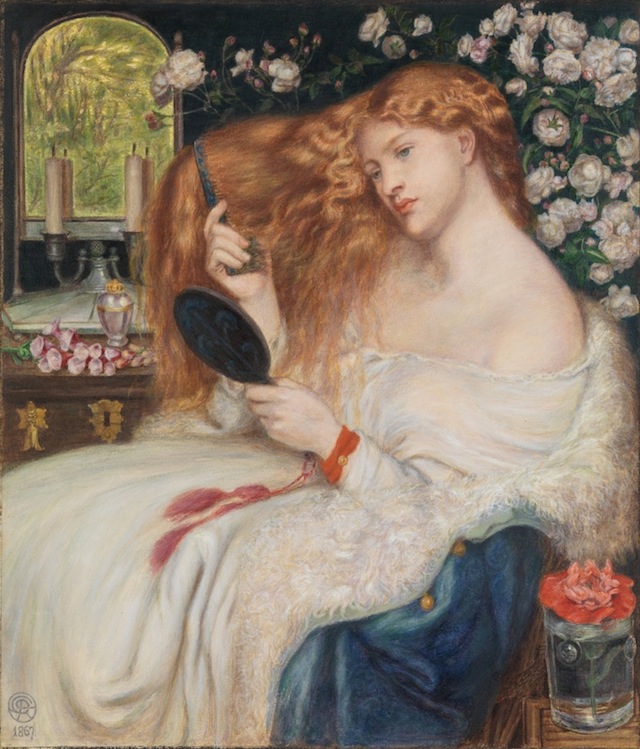
Dante Gabriel Rossetti & Henry Treffry Dunn, “Lady Lilith” (1867), Watercolor and gouache on paper, 20 3/16 x 17 5/16 in. (courtesy the Metropolitan Museum of Art, Rogers Fund, 1908)
Seen in the bottom right corner of Dante Gabriel Rossetti’s “Lady Lilith” (1867) — which is crowded with symbolic flowers — the red poppy often meant imagination and eternal sleep, but also pleasure. As the sonnet Rossetti included with the painting goes: “The rose and poppy are her flowers; for where / Is he not found, O Lilith, whom shed scent / And soft-shed kisses and soft sleep shall snare?”
The Primrose
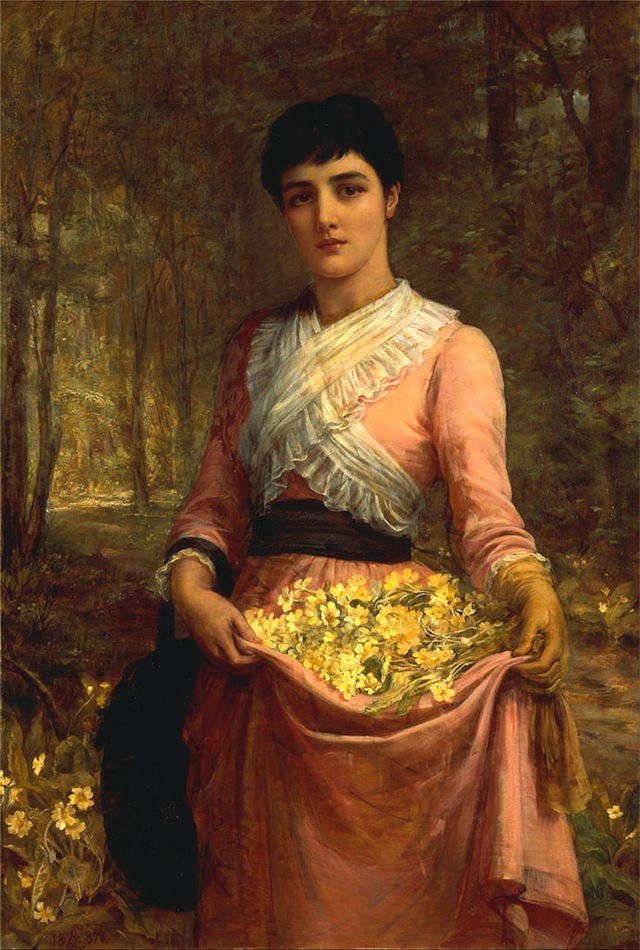
Edwin Long, “The Daughters of Our Empire. England: The Primrose” (1887), oil on canvas (via Yale Center for British Art)
The primrose’s meaning changed with its color, but yellow symbolized youth and young love, here used deliberately in Edwin Long’s “The Daughters of our Empire. England: The Primrose” (1887).
Daffodils
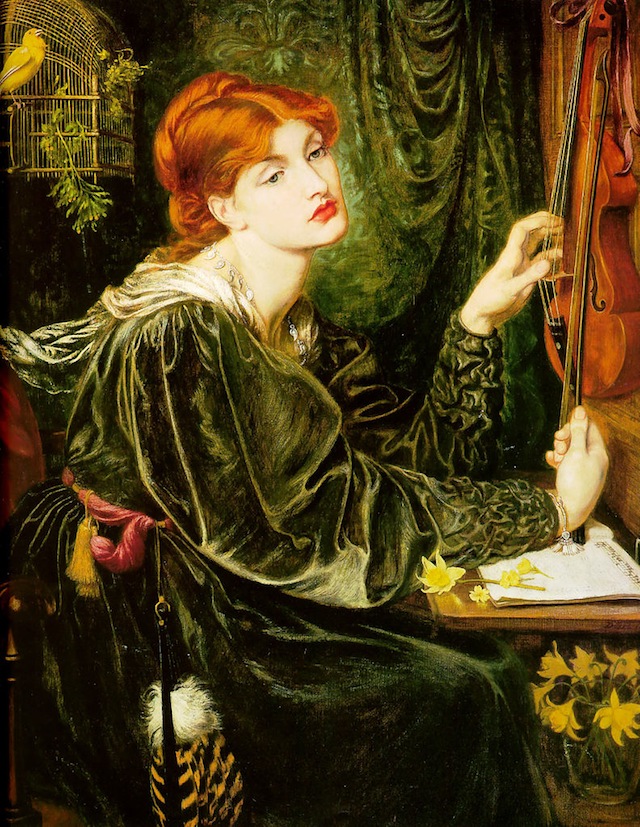
Dante Gabriel Rossetti, “Veronica Veronese” (1872), oil on canvas (via Wikimedia)
Daffodils, with their sunny hues, could mean unrequited love and chivalry, and here rest alongside the scrap of sheet music in Rossetti’s “Veronica Veronese” (1872).
Violets

Ford Madox Brown, “Convalescent, Portrait of the Artist’s Wife” (1872),
Pastel, 18 3/8 x 17 3/8 in. (courtesy the Metropolitan Museum of Art, Rogers Fund, 1909)
Pastel, 18 3/8 x 17 3/8 in. (courtesy the Metropolitan Museum of Art, Rogers Fund, 1909)
Violets are a symbol of modesty and faithfulness. Here in a portrait of his wife Emma Hill, Ford Madox Brown gives his beloved ravaged by alcoholism the redeeming bouquet of the wilted flowers. He wrote: “Now that she is lying in bed thinned with the fever she looks very pictorial and young as ever again.”
Apple Blossoms

Dante Gabriel Rossetti, “A Vision of Fiammetta” (1878), oil on canvas (via Collection of Lord Lloyd-Webber)
An apple blossom could mean good fortune, the promise of better things ahead, or preference, and here Rossetti wraps an idolized woman from a Giovanni Boccaccio poem in its blooms.
Daisies
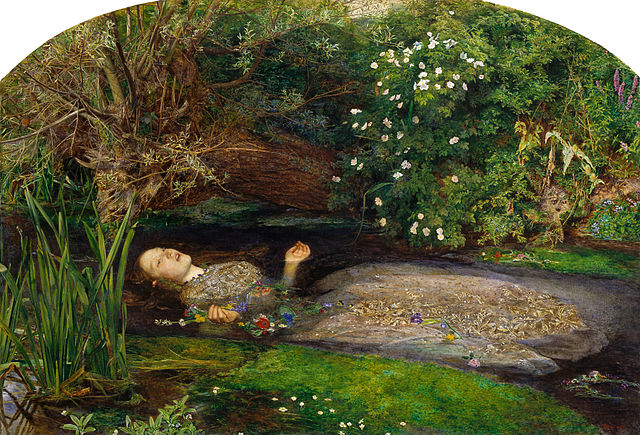
John Everett Millais, “Ophelia” (1851), oil on canvas (via Tate Britain)
When John Everett Millais painted the doomed Ophelia of Shakespeare’s Hamlet, he gave her all the flowers of the original text in the lush scene of death. Included are daisies for innocence, which could also symbolize purity and even “farewell.”
Hawthorn

Edward Burne-Jones, “The Beguiling of Merlin” (1874), oil on canvas (via Wikimedia)
Hawthorn was used to symbolize hope, and also could be used as a charm against magic. Here Merlin is tangled in its branches in an 1874 painting by Edward Burne-Jones.
Roses

Dante Gabriel Rossetti, “Jane Morris – Study for ‘Mariana'” (1868), Red chalk, 35 3/4 x 30 3/4 in. (courtesy the Metropolitan Museum of Art, Gift of Jessie Lemont Trausil, 1947)
Still a common symbol, roses for the Victorians also meant love. Depending on their color, they could indicate the deepness or innocence of that love, ranging from white for purity to burgundy for a unconcious adoration. Here they are pink in a vase in a Rossetti study.
Crocuses
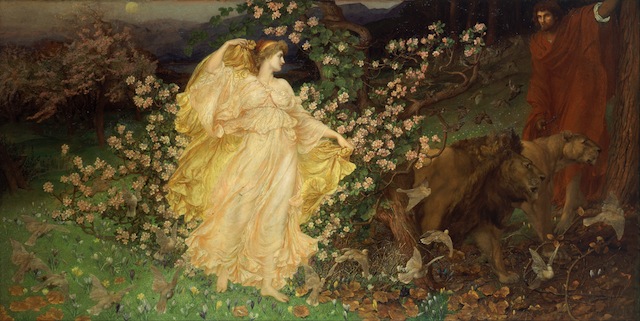
William Blake Richmond, “Venus and Anchises” (1889-90), oil on canvas (via Walker Art Gallery)
Crocuses meant cheerfulness and the gladness of youth, and William Blake Richmond included them here in the spring flowers under the feet of Venus and Anchises.
Honeysuckle

Dante Gabriel Rossetti, “Venus Verticordia” (1868), oil on canvas (via Wikimedia)
While roses fill the area behind Rossetti’s “Venus Verticordia” (1868), honeysuckle flourishes in the foreground, representing sweetness and the bond of love.
Monkshood

Dante Gabriel Rossetti, “La Ghirlandata” (1873), oil on canvas (via Guildhall Art Gallery)
Poisonous monkshood, its blue flowers representing that the viewer should beware of a danger that might be ahead, rests at the foot of this harp topped with the beguiling honeysuckle and roses in Rossetti’s “La Ghirlandata.” Or at least that’s what he intended. He accidentally depicted the innocuous larkspur instead.
For more on the Victorian meaning of flowers, here’s an index of the Victorian Flower Code. The Pre-Raphaelite Legacy British Art and Design continues at the Metropolitan Museum of Art (1000 5th Avenue, Upper East Side, Manhattan) through October 26.
No comments:
Post a Comment